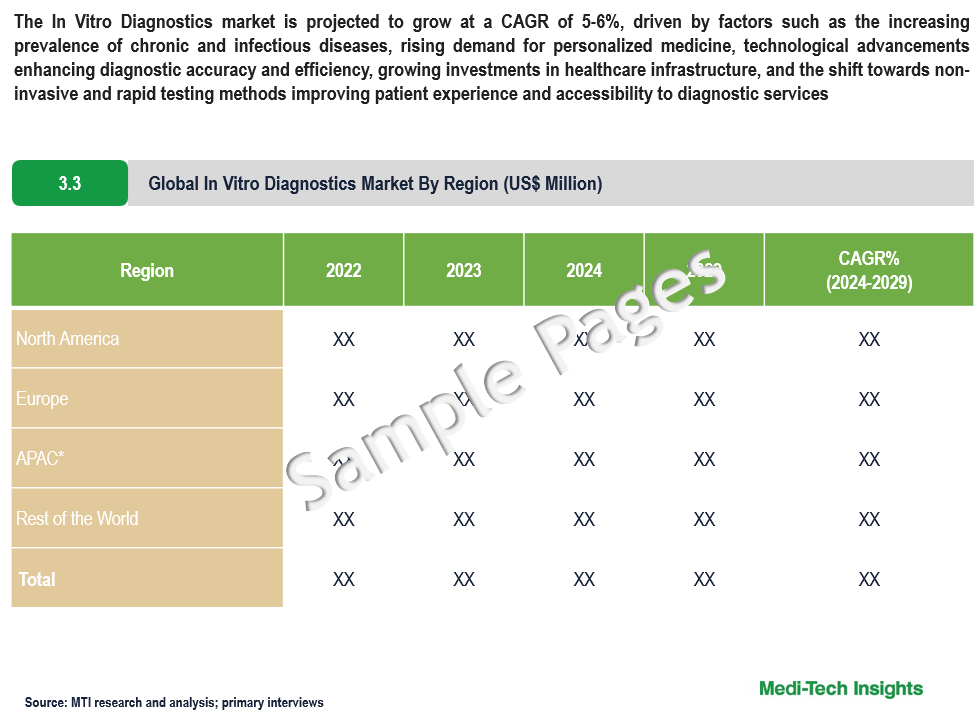
In Vitro Diagnostics (IVD) Market Size, Share, Growth, Global Industry Analysis for Forecast 2024 to 2029
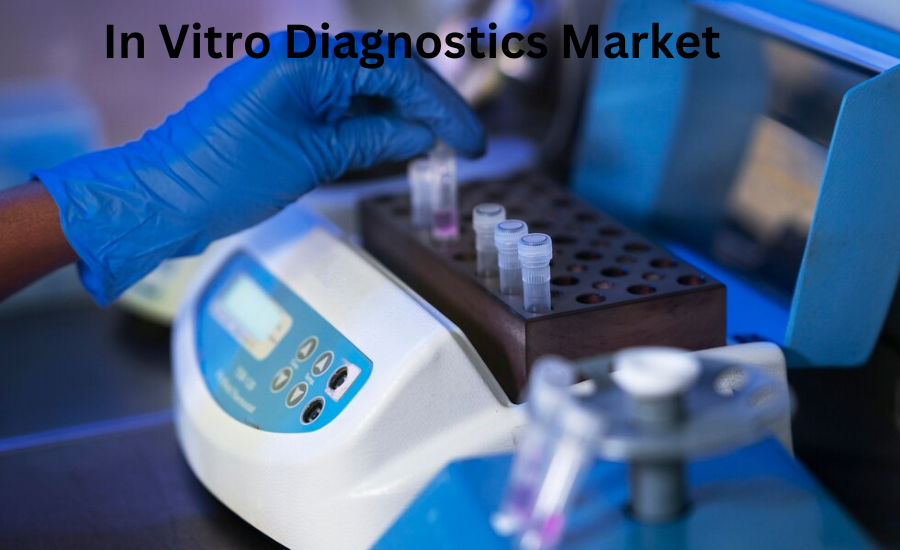
The In Vitro Diagnostics (IVD) market is projected to grow at a CAGR of 5-6%, driven by factors such as the increasing prevalence of chronic and infectious diseases, rising demand for personalised medicine, technological advancements enhancing diagnostic accuracy and efficiency, growing investments in healthcare infrastructure, and the shift towards non-invasive and rapid testing methods improving patient experience and accessibility to diagnostic services. To learn more about the research report, download a sample report.
The IVD market refers to the segment of the healthcare industry that deals with diagnostic tests conducted on bodily samples like blood, urine, tissue, and more, outside the body. These tests are typically performed in a laboratory setting and are crucial for detecting diseases, monitoring health conditions, and guiding treatment decisions. The IVD market encompasses a wide range of diagnostic products and technologies, including:
- Clinical Chemistry: Tests measuring levels of substances in bodily fluids like blood and urine, such as glucose, cholesterol, and electrolytes
- Immunoassays: Tests detecting specific proteins, hormones, or antibodies in the blood or other bodily fluids, often used in diagnosing infections, autoimmune disorders, and cancer.
- Molecular Diagnostics: Techniques detecting genetic material (DNA or RNA) to diagnose genetic disorders, infectious diseases, and cancer, among others
- Point-of-Care Testing (POCT): Rapid diagnostic tests performed near the patient, outside of traditional laboratory settings, allowing for quick results and immediate treatment decisions
- Hematology: Analysis of blood cells and their components, essential for diagnosing blood disorders, and anaemia, and monitoring treatment for conditions like leukemia
- Microbiology: Identifying microorganisms causing infections and determining their susceptibility to antibiotics
Navigating the Intersection of Health Needs and Technological Advancements in In Vitro Diagnostics
With advancements in genomic testing and molecular diagnostics, there's a growing demand for personalized medicine. IVD technologies that enable genetic testing, pharmacogenomics, and companion diagnostics are witnessing significant growth. The global rise in the aging population and the prevalence of chronic diseases like cancer, diabetes, and cardiovascular diseases are driving the demand for diagnostic tests. Early detection and monitoring of these conditions through IVD technologies are crucial for effective disease management. Technological advancements such as lab automation and molecular diagnostics improve the accuracy and efficiency of diagnostic testing, driving market growth. For instance,
- In March 2024, bioMérieux obtained FDA 510(k) clearance and CLIA waiver approval for its BIOFIRE® SPOTFIRE® Respiratory/Sore Throat (R/ST) Panel, a multiplex PCR test capable of rapidly detecting and identifying nucleic acids from up to 15 common pathogens causing respiratory or sore throat infections within about 15 minutes, using samples obtained from either nasopharyngeal or throat swabs
- In December 2023, Thermo Fisher Scientific Inc. unveiled the Thermo Scientific KingFishe Apex Dx, an automated nucleic acid purification instrument, alongside the Applied Biosystems MagMAX Dx Viral/Pathogen NA Isolation Kit, designed for isolating and purifying viral and bacterial pathogens from respiratory biological specimens, offering laboratories IVD and IVD-R approved automated sample preparation solutions for increased confidence in downstream results
The COVID-19 pandemic has highlighted the importance of diagnostics in disease containment and management. Rapid diagnostic tests, molecular assays, and serological tests for COVID-19 have experienced unprecedented demand, accelerating innovation in IVD technologies and testing methodologies. Post-pandemic there is a shift towards home-based testing and self-monitoring devices, driven by factors such as convenience, cost-effectiveness, and the increasing emphasis on patient-centric care. IVD companies are focusing on developing user-friendly, portable devices for home diagnostics. Moreover, growing investments in healthcare infrastructure, particularly in developing countries, expand access to diagnostic services. Governments and healthcare organizations are investing in upgrading healthcare infrastructure and promoting preventive healthcare measures, which include routine diagnostic testing. Overall, the emphasis on early disease detection and prevention, along with expanding applications in companion diagnostics and precision medicine, further catalyze the growth of the IVD market.
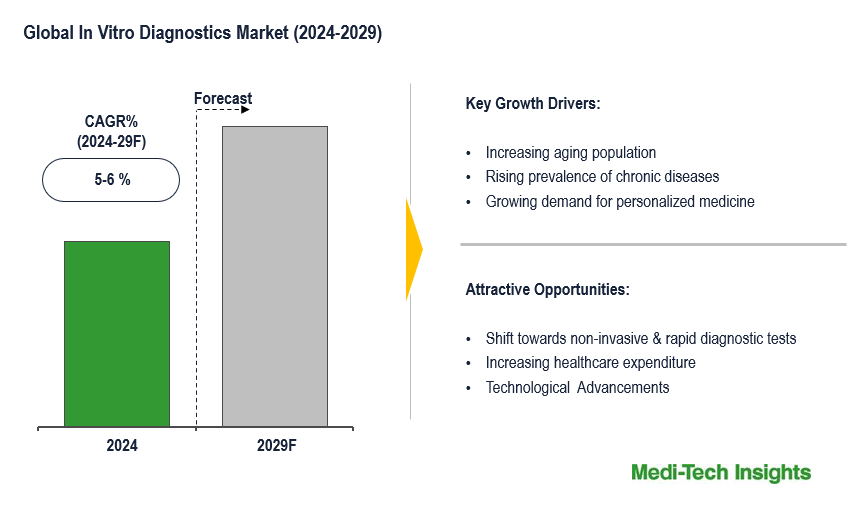
To learn more about this report, download the PDF brochure
Shaping the Future of IVD: Emerging Technologies and Trends
In the realm of in vitro diagnostics (IVD), several emerging technologies and trends are reshaping the landscape of diagnostic testing. Next-generation sequencing (NGS) is revolutionizing genomic diagnostics by enabling comprehensive analysis of genetic variations associated with diseases, particularly in oncology and genetic disorders. Liquid biopsy is gaining prominence as a non-invasive method for detecting and monitoring cancer, offering insights into disease progression and treatment response. Digital pathology is transforming histopathology by digitizing slides and leveraging image analysis algorithms for remote consultation and improved workflow efficiency.
The integration of AI, machine learning, and data analytics in IVD platforms is revolutionizing diagnostic capabilities. These technologies enable predictive analytics, pattern recognition, and more accurate interpretation of diagnostic results, thereby improving clinical decision-making and patient outcomes. Moreover, Point-of-Care Testing (POCT) devices are enabling rapid and decentralized diagnostic testing, while biosensors and microfluidics are driving the development of portable and miniaturized diagnostic platforms for point-of-care and remote testing applications. These emerging technologies and trends are poised to shape the future of IVD by enhancing diagnostic capabilities, improving patient outcomes, and driving innovation in healthcare delivery.
Key Constraints/Challenges
The IVD market faces significant challenges that may hinder its growth. Evolving regulatory landscapes and operational complexities in conducting diagnostic tests are anticipated hurdles. The rising number of reimbursement issues and government-driven regulatory changes will further impede market expansion. These challenges include delays in product introduction, high development costs limiting innovation, and variations in reimbursement policies hindering widespread adoption. Additionally, rapid technological advancements, market fragmentation, and competition from alternative diagnostic methods add further complexity and affect the market growth.
Regional Analysis of the IVD Market
North America stands out prominently in the IVD market, driven by its sophisticated healthcare infrastructure, favourable reimbursement policies, and the elevated prevalence of chronic ailments. Similarly, Europe holds a considerable share of the IVD market, owing to its robust healthcare systems and the escalating uptake of cutting-edge diagnostic technologies. Meanwhile, the Asia-Pacific region is undergoing rapid market expansion propelled by enhancements in healthcare infrastructure, surging healthcare expenditures, and heightened awareness regarding early disease detection. Notably, nations such as China, India, Japan, and South Korea are at the forefront of driving market growth in Asia-Pacific, underscoring the region's burgeoning importance in the global IVD landscape.
Regulatory reforms aimed at streamlining approval processes for IVD products and ensuring their safety and efficacy are easing market access for manufacturers. The harmonization of regulations and standards across different regions is fostering international market expansion opportunities for IVD companies. Furthermore, emerging markets offer substantial growth potential for IVD manufacturers due to improvements in healthcare infrastructure, rising disposable incomes, and increasing awareness about preventive healthcare measures. Companies are strategically expanding their presence in regions such as Asia-Pacific, Latin America, and Africa to capitalize on these opportunities.
Competitive Landscape
The global IVD market is highly competitive, with key players including Roche Diagnostics, Abbott Laboratories, Siemens Healthineers, Danaher Corporation, Thermo Fisher Scientific, Agilent, and Biomerieux among others.
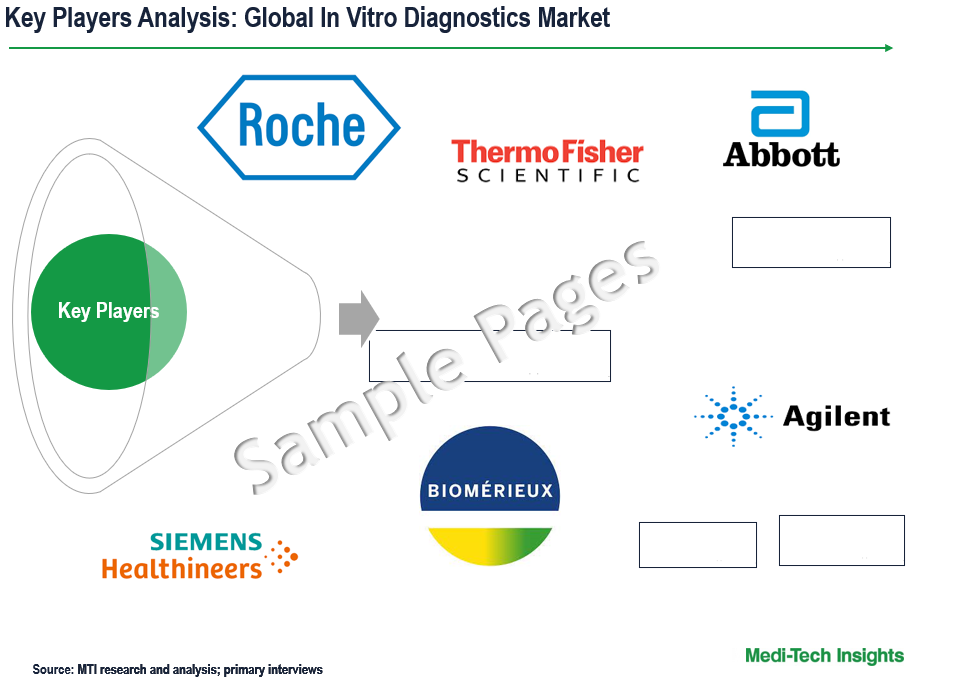
Get a sample report for competitive landscape analysis
Organic and Inorganic Growth Strategies Adopted by Players to Establish Their Foothold in the Market
Players operating in this market are adopting both organic and inorganic growth strategies such as collaborations, and acquisitions to garner market share. For instance,
- In November 2023, Newland EMEA introduced a new line of IVD (in vitro diagnostics) products for the healthcare sector and introduced these innovations at MEDICA, the largest medical industry tradeshow, in Dusseldorf
The IVD Market is expected to gain momentum in the coming years due to the rising aging population, growing demand for personalized medicine, technological advancements, strategic collaborations and aggressive organic and inorganic growth strategies followed by the players.
Key Strategic Questions Addressed
-
What is the market size & forecast for the Global IVDMarket?
-
What are the historical, present, and forecasted market shares and growth rates of various segments and sub-segments of the Global IVD Market?
-
How has COVID-19 impacted the Global IVD Market?
-
What are the major growth drivers, restraints/challenges impacting the market?
-
What are the opportunities prevailing in the market?
-
What is the investment landscape?
-
Which region has the highest share in the global market? Which region is expected to witness the highest growth rate in the next 5 years?
-
Who are the major players operating in the market? What is the competitive positioning of key players?
-
Who are the new players entering the market?
-
What are the key strategies adopted by players?
- Research Methodology
- Secondary Research
- Primary Research
- Market Estimation
- Market Forecasting
- Executive Summary
- Market Overview
- Market Dynamics
- Drivers
- Restraints
- Opportunities
- Market Dynamics
- Global In Vitro Diagnostics Market - Size & Forecast (2021-2028), By Product
- Reagents
- Instruments
- Services
- Global In Vitro Diagnostics Market - Size & Forecast (2021-2028), By Technology
- Microbiology
- Haematology
- Coagulation
- Others
- Global In Vitro Diagnostics Market - Size & Forecast (2021-2028), By Application
- Infectious Diseases
- Diabetes
- Oncology
- Cardiology
- Others
- Global In Vitro Diagnostics Market - Size & Forecast (2021-2028), By End User
- Hospitals
- Clinical Laboratories
- Home-Care Settings
- Other End Users
- Global In Vitro Diagnostics Market - Size & Forecast (2021-2028), By Region
- North America (U.S. & Canada)
- Europe (UK, Germany, France, Italy, Spain, Rest of Europe)
- Asia Pacific (China, India, Japan, Rest of Asia Pacific)
- Rest of the World (Latin America, Middle East & Africa)
- Competitive Landscape
- Key Players and their Competitive Positioning
- Competitive Positioning of Key Players (2022)
- Offerings Assessment, By Players
- Key Strategies Assessment, By Player (2021-2023)
- New Product Launches
- Partnerships, Agreements, & Collaborations
- Mergers & Acquisitions
- Other Developments
- Key Players and their Competitive Positioning
- Key Companies Scanned (Indicative List)
- Roche Diagnostics
- Abbott Laboratories
- Siemens Healthineers
- Danaher Corporation
- Thermo Fisher Scientific
- Agilent
- Biomerieux
- Other Players
The study has been compiled based on extensive primary and secondary research.
Secondary Research (Indicative List)
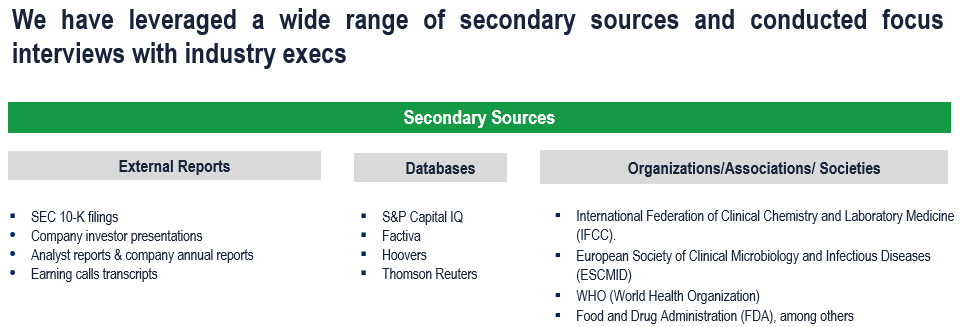
Primary Research
To validate research findings (market size & forecasts, market segmentation, market dynamics, competitive landscape, key industry trends, etc.), extensive primary interviews were conducted with both supply and demand-side stakeholders.
Supply Side Stakeholders:
- Senior Management Level: CEOs, Presidents, Vice-Presidents, Directors, Chief Technology Officers, Chief Commercial Officers
- Mid-Management Level: Product Managers, Sales Managers, Brand Managers, Business Development Managers, Consultants
Demand Side Stakeholders:
- Stakeholders in Hospitals, Clinical Laboratories, and Home-Care Settings among others
Breakdown of Primary Interviews
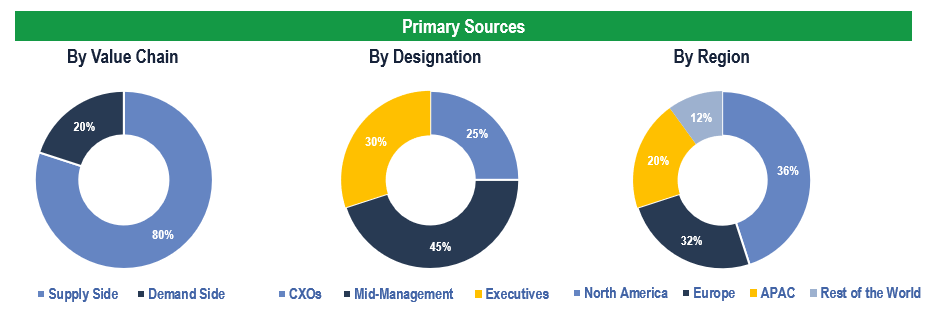
Market Size Estimation
Both ‘Top-Down and Bottom-Up Approaches’ were used to derive market size estimates and forecasts.
Data Triangulation
Research findings derived through secondary sources & internal analysis were validated with Primary Interviews, Internal Knowledge Repository, and Company Sales Data.

